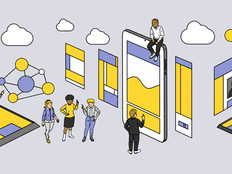Virtual reality offers a highly immersive experience, but it’s always lacked one critical element: the sense of touch. In a world of remote learning and social distancing, tactile sensations are sorely missing — but perhaps not for much longer.
Researchers at Northwestern University have devised a way to mimic the sensation of human touch with an epidermal VR device. Featuring an array of tiny, vibrating, programmable components called actuators, the device adheres to a user’s skin like a bandage, using a silicone polymer material. The device can be placed anywhere on the body. The number and placement of devices depends on how the technology is used and for what purpose.
“Imagine the little buzzer in your Apple Watch,” says John Rogers, an engineering professor at Northwestern who worked on the technology with Yonggang Huang, also an engineering professor. “It’s like putting Apple Watches all over your body, but not in such a rigid form — in that thin, skinlike form factor, so what you feel is like a gentle touch.”
Potential Use Cases for Epidermal VR
Rogers and Huang originally created the epidermal VR device to monitor the progress of speech patterns and swallowing in stroke survivors after physical rehabilitation. The device transmits information to the patient’s rehab specialist and also alerts the patient to irregular swallowing or speaking patterns through tactile feedback.
The researchers then realized that if the arrays of actuators were programmable, “you could create an immersive experience that would have relevance to virtual reality, where your current systems are dominated by auditory and visual cues,” explains Rogers. “If you go beyond the eyes and ears and include touch, it could profoundly expand the impact of VR or AR, especially in the context of remote instruction and the rise of social media.”
For higher ed institutions, the potential uses for this innovative tech are numerous. Epidermal VR applied to surgical training would offer tactile input from the instructor to help a student more precisely understand proper positioning and movements. Physical therapy training would similarly benefit from this technology.
“One could remotely and gently provide tactile feedback to certain types of motions, to guide those motions in an instructional sense to improve therapy techniques, exercise methods and limb positioning,” Rogers says.
He also imagines the use of epidermal VR within the creative arts, including instruction around dancing and movement, or even “a tactile aspect to experiencing a form of art.”
MORE ON EDTECH: Virtual reality unlocks a new dimension of learning.
The booming world of esports is another obvious candidate for epidermal VR, along with physical sports and musical training. With the VR devices helping students hold the correct postures, a remotely located teacher could guide a class through processes that use mechanical manipulation.
Although the battery-free device currently weighs just a few grams per every 10 square centimeters, Rogers says the platform will get thinner and lighter. Ultimately, users can wear the device like a fully programmable second skin. Once it’s ready for mass manufacturing in a couple of years, the device could be tailored to any size and shape and could also even heat and cool the skin to more closely mimic the sensation of warmth from another person’s fingers.











